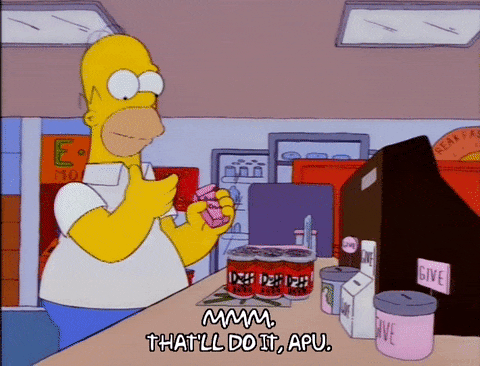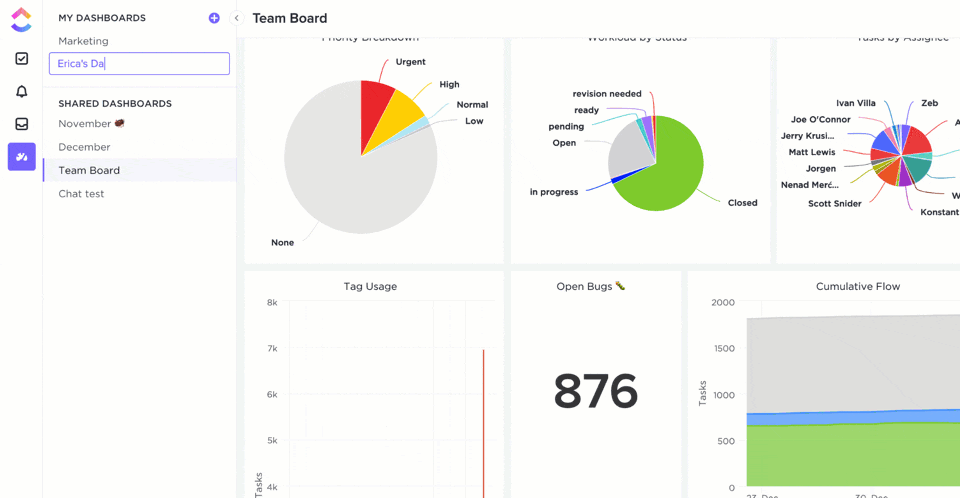

Product management is not an easy job.
There are tons of things that can impact your product strategy. From new competitors to changing customer preferences, how do you make sure your product stays relevant?
Although product management is unpredictable, you can still predict your success through OKRs.
Looking for the perfect product OKRs?
In this article, we’ll cover what product OKRs are, go over ten fantastic product management OKR examples, and highlight the best project management software to help you manage and track those product OKRs.
Let’s get going!
What Is A Product Management OKR?
We’ll begin by breaking down what OKRs are.
Contrary to popular belief, OKRs aren’t something Cardi B came up with.
They’re even better!
OKR stands for Objectives and Key Results.
The OKR framework focuses on goal setting and helps you create measurable outcomes that drive your company towards success.
An objective is where you want to be, and a key result is a strategy for how you’re going to get there.
Since OKRs are all about goal setting, OKRs for product managers must be about setting goals to make your product a success. The beauty of OKRs is that they can help you easily check off items on your product roadmap.
Speaking of which, take a look at some examples of OKRs that ClickUp uses!
Before we get into the product management examples, there are a few rules to writing meaningful OKRs.
Make sure your OKRs are:
- Aligned: make sure that the objective contributes to the company’s overall vision
- Specific: similar to SMART goals, you need to define your objective and key results clearly
- Time-bound: a good OKR always has a time limit ⏳
- Measurable: make sure to set measurable goals so that you can quantify your success
- Ambitious: and lastly, don’t be afraid to dream big! 💫
Use a balanced scorecard template to identify your team’s OKRs!
10 Examples Of Product OKRs
Here are ten examples of product OKRs that will lead your product team to success:
A. Marketing OKRs
Marketing OKRs help you with your product marketing strategy.
These goals focus on achieving product-market fit and making sure that customers know of your full line of products.

1. Objective: Implement a weekly newsletter successfully
Key Results:
- Decide on and finalize the content strategy, key topics, and messages for the six months
- Achieve a 45% open rate
- Grow our email subscriber base by 10% each week
- Get to 20 000 readers by the second quarter
2. Objective: Optimize our marketing funnel
Key Results
- Run 35 user interviews with the target audience
- Increase our visitor to trial conversion rate from 6% to 12%
- Increase trial to paid conversion from 18% to 45%
3. Objective: Improve brand engagement
Key Results:
- Increase the number of active users from 1000 to 5000
- Increase the number of customer success stories on our website from 2 to 10
- Increase engagement through LinkedIn from 20% to 60%
- Update and share our product roadmap
B. Sales OKRs
Sales OKRs are goals that any product leader needs to have.
Why?
Sales OKRs are your money-makers!
They aim to get people to buy your product.

Here are two examples:
4. Objective: Successfully launch the second version of our main product by the start of the second quarter.
Bonus: Product Launch Templates
Key Results:
- Have four product discovery meetings
- Get 900 new sign-ups
- Increase our sign-up to trial ratio to 30%
- Increase our trial to paid ratio to 50%
5. Objective: Increase the nationwide reach of our product by 50% by the first quarter of the following year
Key Results:
- Expand our distribution channel to become the third-largest in the state
- Expand sales ventures to one new state every three months
- Create an e-commerce website to expand the reach of our product
6. Objective: Successfully participate in 10 trade events this year
Key Results:
- Register for 10 trade events
- Give product demos to 30 prospects per day at each event
- Collect the contact details of at least 300 prospects per event
C. Customer OKRs
Customer OKRs are goals that make your customers want to stay with your product.
Goals such as keeping your customers happy, and providing the right products will make customers fall in love with your product!
And ideally, even obsess over them…

Here are two examples:
7. Objective: Improve customer satisfaction by 45% by the third quarter
Key Results:
- Increase our Net Promoter score from 7.0 to 8.5
- Reduce the number of requests to support from 3.5 to 1.0 per user per month
- Call 50 churned customers to find out why they left
- Use a CRM tool to better manage client relationships
8. Objective: Improve customer engagement by 50% by the third quarter
Key Results:
- Increase monthly customer retention rates from 40% to 60%
- Increase the average time spent on our app from 10 mins to 20 mins by implementing a stellar in-app chat ui
- Increase the number of unique visits to our website from 500 to 1000 visits per day
D. Employee Engagement OKRs
Employee engagement OKRs aim to improve the performance and engagement of your product team.
Product team OKRs can include improving team synergy or training your sales team to learn all sorts of cool tricks to promote your product:

Here are two examples:
9. Objective: Improve product team learning by 45% by the end of the year.
Key Results:
- Hold bi-annual meetings for old and new staff members to educate them on your company culture and history
- Send out monthly quizzes to teach the product team about old and new features
- Conduct weekly knowledge sharing sessions held by product team members
10. Objective: Improve the performance of our product team
Key Results:
- Implement a balanced scorecard and other performance metrics and KPIs for the team
- Host 2 yearly off-site team meetings to celebrate the new product releases (Check out our guide on release management tools!)
- Implement one team-building exercise per month
The Best Way To Manage Your Product OKRs
Fantastic!
You now have a list of objectives and a strategy to achieve them.
But that’s not where it ends.
To make sure your product strategy is a success, you need to manage and track those OKRs.
So, how do you do this?
Unfortunately, just carrying a list of OKRs with you isn’t going to get you very far…

An OKR tool is going to help get much farther!
OKR software like ClickUp can help you set, track, and manage all your product OKRs.
Additionally, they can help you communicate your product goal to the entire company so all your employees can align their team-based goals with the overall company objective.
Here’s how ClickUp can help product teams:
1. Goals Setting (Objectives)
Goals are high-level containers that can be broken down into smaller, measurable Targets.

Since OKRs are all about planning ahead, let’s clear up some confusion that might occur ahead:
- Your objectives = ClickUp Goals
- Your key results = ClickUp Targets
It’s also super easy to set product OKRs in ClickUp:
Go to “Goals” in ClickUp and create a new Goal by clicking the “+ New Goal” button.

It sure is 🍋
You can also edit details about your Goals:
- The name of your Goal
- Your Goal’s due date
- Who’s responsible for your Goal
- Who has access to your Goal
- The Goal description

Want to know how to set effective team goals? Here are 7 steps to efficiently set team goals.
2. Targets
Once you’ve set your objective, you need to come up with a few key results.
You can do this by clicking on the “Add Target” button.
You’ll then find your Targets right below your overall Goal.

You can also edit details about your Targets like:
- Your Target’s name
- Who’s responsible for the Targets
- Target type
Here are the different types of Targets:
- Number: numerical figures such as the revenue generated from new products
- True/False: enter if something has been done or not
- Currency: keep track of your 💸
- Tasks: track the number of product tasks completed. For example, a checklist for the pre launch testing phase
This way…

3. Progress Tracking
Once your Goals (objectives) and Targets (key results) are ready to go, you need to track your progress towards those OKRs.
Here’s what you can track:
1. Your progress for each Target (key result)
For example, if your Target is to get published product reviews in 10 publications by March 2021, you can track how many publications your product has appeared in so far.
2. How your Target progress has contributed to your Goal’s (objective) progress
For example, if you’ve completed less than a quarter of your targets so far, your OKR Goal progress will be 20%.

But why do you need to track your progress?
Without progress tracking, you’ll never know if you’re even getting any closer to your Goals:

While that little guy takes a stroll, let’s talk about how Agile teams (the most successful teams in the world) can also use ClickUp to monitor the progress of an Agile Sprint Goal.

Here’s how you can do it:
- Add a Sprint Goal in the same way you add a regular Goal and choose a name (Ex. “Sprint 3.0”)
- Assign the Goal to your product manager
- Choose a due date for Sprint completion
- Link any Lists or Tasks to your Sprint Goal
This way, your product owner and Scrum team can see their Goal progress update in real-time.
4. Dashboards
ClickUp has Product Dashboards to help you plan, track, and assess your Goal progress through completed tasks and time tracked on projects.

You can also add Custom Widgets to your product Dashboard.
Widgets give you detailed insights into tasks, Sprints, people, and projects.
Here’s a list of some of the Widgets you can choose from:
- Statuses: see the number of tasks in progress, and the number of closed and completed tasks
- Time Tracking: add details from timesheets, billable time, time tracked, time estimates, and more
- Calculation: calculate sums, averages, and so much more for any task
- Portfolio: categorize and track the progress of any of your Lists or Folders
- Chat: have discussions with team members within your Dashboard

Product OKR FAQs
Still confused about all the different kinds of OKRs out there?
Let’s answer a few questions you might have:
1. What Are The Different Types Of OKRs?
Here are four key types of OKRs that you need to know:
- Personal OKRs
- Individual OKRs
- Company OKRs
- Quarterly OKRs
2. What are the Steps in the Product OKR Process?
To have an effective OKR process for your product team, follow these steps below:
- Establish goals.
- Create actionable and measurable OKRs.
- Establish a check-in timeline. We recommend checking OKRs on a quarterly basis.
- Review and reflect on OKRs.
3. How many OKRs should a product team have?
Although there is no set rule for how many OKRs a product team should have, we recommend setting 2-5 OKRs per quarter. Make sure your OKRs are measurable, time-bound, and specific!
Not sure how to write OKRs? Here’s how to write effective OKRs.

4. What’s The Difference Between MBO And OKR?
Here are the main differences between OKR and MBO:
| Parameter | OKR | MBO |
| Meaning | Objectives and Key Results | Management by Objectives |
| Focus | The OKR process focuses on the “what” and “how” | MBO focuses solely on the “what” |
| Timeline | Monthly or quarterly | Annually |
| Approach | OKRs are public, transparent and widely communicated | MBOs are siloed and private |
| Methodology | The OKR methodology consists of objectives that have key results under them. | Set company objectivesCommunicate objectives to employeesMonitorEvaluate performanceReward performance |
| Compensation | Usually not tied to compensation | Tied to compensation. For example, bonuses. |
| Type of goals | OKRs more ambitious and aspirational | Similar to a KPI, MBO avoids risks and focuses on realistic goals |
Also learn more about the differences between KPIs and OKRs.
Time To Ace Your Product Strategy 🃑
Product OKRs help you determine goals and devise a way to achieve them.
They also help you track your progress since once a key result is completed, you’re one step closer to reaching that goal.
Building a product roadmap that follows the OKR structure also helps teams focus on building things that matter most.
But, as we all know, humans are forgetful, and sometimes we all need a little motivation.
Luckily, an OKR product management tool like ClickUp is all you need to remind and motivate you!
With built-in Reminders, Recurring Tasks, and Agile Sprints, you’ll be crushing all your product OKRs like nobody’s business.
Get ClickUp for free today to take your product to the next level! 📈




